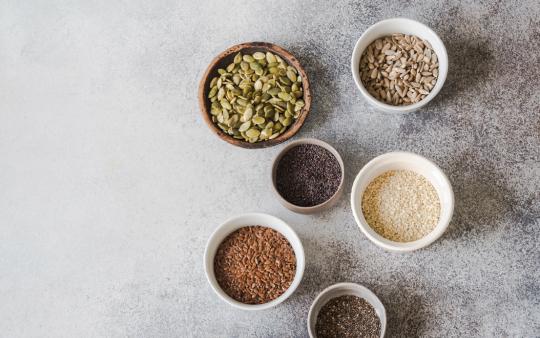Seed Cycling: a Natural Path to Hormone Balance
| © Can Stock Photo / senteliaolga |
Hormone imbalance is an issue many women struggle with and it can be challenging to find a solution that doesn’t come with a host of other problems. We know that what we eat can impact many aspects of our health, but did you know that some foods may have the power to help correct some of the symptoms of hormone imbalance? Seeds, packed with nutrients that hormones depend on, and consumed in a prescribed way known as seed cycling, are one group of foods that have the potential to safely and gently get your cycle back on track!
What is seed cycling?
Seed cycling involves rotating seed consumption based on the phase of the menstrual cycle you’re in. Though tiny, they’re nutritional powerhouses, containing high amounts of essential fats, minerals, and vitamins which support both the production and metabolism of estrogen and progesterone. The seeds used in seed cycling contain essential fatty acids (omega-3 and omega-6) as well as an important type of phytoestrogen known as lignans which have been shown to have both estrogenic and anti-estrogenic activity. This means they weakly interact with estrogen receptors (upregulation) and bind excess estrogen to ensure optimal metabolism and elimination (downregulation), resulting in an overall modulatory effect to help balance estrogen and progesterone. The essential fatty acids and their metabolites, gamma-linoleic acid (GLA) and alpha-linolenic acid (ALA), can also positively affect hormone profiles. The practice of seed cycling makes use of the varying ratios of fatty acids, vitamins, and minerals in different seeds to support healthy estrogen and progesterone levels in the follicular and luteal phase of menses.
Seeds commonly used in seed cycling
Flaxseed is the most well-researched of the seeds used in seed cycling, and also has the most evidence-based research. It’s been shown to promote ovulation and lengthen the luteal phase, regulate menses, as well as reduce cyclic breast pain.
Pumpkin seeds are rich in zinc, which has been shown to be important for ovulation and the metabolism of estrogen, progesterone and testosterone, and has been studied for its beneficial effects on period pain.
Sesame seeds have also been studied for their hormone-balancing effects and have been shown to induce menstruation in those with irregular menses. One small randomized controlled trial compared progesterone therapy with sesame consumption in initiating and maintaining menstrual bleeding, and concluded that due to its safety, efficacy, and tolerability, sesame should be considered in those for whom hormone replacement therapy is not an option.
Sunflower seeds contain high levels of omega-6 fatty acids, which can be converted into gamma linoleic acid (GLA) in the body. The oil of sunflower seeds is also high in selenium, which can alter estrogen receptor expression and is necessary for healthy liver function (how hormones are cleared from the body).
Seed cycling for hormonal imbalances
Cyclic Mastaglia (breast tenderness): A condition associated with higher estrogen levels, studies have shown flaxseed to be an effective treatment, possibly due to flaxseed’s ability to modulate estrogen.
Oligomenorrhea (irregular menses): Several studies have shown that seed lignans can induce menstruation.
Polycystic Ovary Syndrome (PCOS): Flaxseeds have been shown to have a beneficial effect on insulin metabolism in women with PCOS. They are also believed to be helpful with both decreasing the pain and increasing the regularity associated with menstrual cycles. Additionally, lignans were found to decrease testosterone and increase sex-hormone binding globulin (SHBG), a protein made by the liver that carries estrogen and androgens through the blood which in turn determines the amount of hormone available to be used by the body.
Period Pain: The omega-3 fatty acids found in seeds can help to decrease inflammatory prostaglandin levels, while the lignans support healthy estrogen metabolism, helping to reduce the pain associated with menstrual cramps.
Premenstrual Syndrome (PMS): By introducing seeds that are high in essential fatty acids, the abnormal ratios of fatty acids often associated with PMS can be normalized, reducing associated symptoms.
Cancer Risk: Additionally, increased intake of dietary lignans reduced the risk of post-menopausal breast cancers as well as estrogen-dependent colon tumors. Sunflower, flax, and pumpkin seeds have been specifically shown to be protective against breast cancer.
Menstrual cycles and moon phases
The seed cycling protocol is quite simple and can be done according to either the menstrual cycle (if it’s fairly regular) or according to the phases of the moon (if the menstrual cycle is absent or too irregular). Keep in mind, this gentle process takes time! You’ll need to track and have good knowledge of your monthly cycle to know when to integrate the different seeds. In general, expect to wait at least three cycles to see improvement.
Menstrual cycle basics
To understand how seed cycling works, we first need to understand that the menstrual cycle is composed of two phases:
The follicular phase occurs from the first day of menses to ovulation (typically cycle days 1–14). Estrogen is the dominant hormone, responsible for stimulating growth of the uterine lining.
The luteal phase occurs from ovulation to the first day of menses (typically cycle days 15–28). Progesterone rises in the luteal phase and matures the endometrium in preparation for pregnancy. If pregnancy does not occur, progesterone levels fall and lead to menses.
When menstrual cycles are irregular or absent, seed cycling can be done according to the moon phases. Since both moon and menstrual cycles are typically 28 days, the moon phases can provide a template for timing seed cycling. When tracking according to moon phases, the new moon stands in for the first day of menses, while the full moon corresponds to ovulation. Start the follicular phase seeds on the first day of the new moon, and begin the luteal phase seeds on the first day of the full moon.
A simple seed cycling protocol
Follicular phase (From day 1 to 14, or until ovulation) or from new moon to full moon
Each day, consume:
1 Tbsp of freshly ground flax seeds
1 Tbsp of freshly ground pumpkin seeds
Luteal phase (From day 15, or from ovulation, to 28) or from full moon to new moon
Each day, consume:
1 Tbsp of freshly ground sesame seeds
1 Tbsp of freshly ground sunflower seeds
Seed preparation, storage, and use
Freshly ground seeds can be sprinkled on salads, vegetables, and cereals. They can also be added to smoothies or mixed with a little nut milk. Since seeds are high in healthy oils, the fatty acids within them can oxidize and become rancid, making it important to consume only freshly ground seeds. Use a coffee or spice grinder, and either use right away, and store the ground seeds in the fridge in a glass jar with a tight-fitting lid for up to four days. While seed cycling is not a replacement for other hormone-balancing therapies, it does offer a safe, simple, and effective way of supporting the body’s hormone production that can be easily incorporated into daily life. Remember that if you are experiencing a hormone imbalance, it is important to have a proper assessment done and to receive a targeted treatment plan. In the meantime, consider trying seed cycling as the first step on your way to healthy hormones!
Interested in learning more? Check out more EcoParent, including myths and facts about hormones, more natural ways to treat hormone imbalances, and the phases of the menstrual cycle explained simply.






